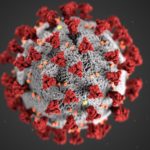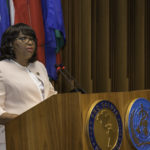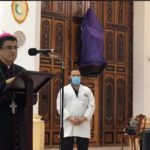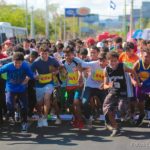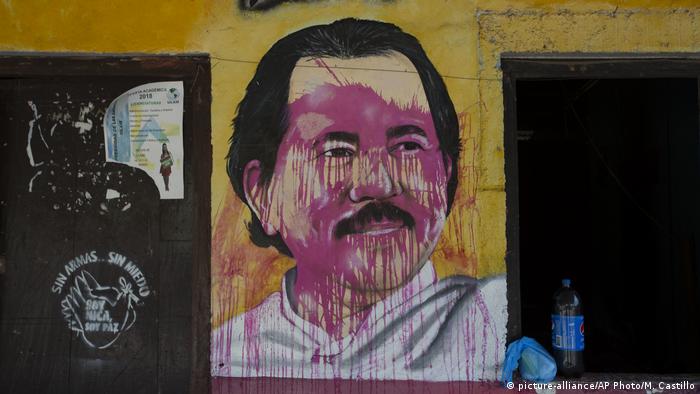
A mural of Nicaraguan President Daniel Ortega defaced with red paint
Nicaragua has been going through its most serious political crisis since April of 2018, when protests began in Managua, and violent government repression isn’t stopping or slowing down. As of June 19, over 200 people have died in violent clashes with police and paramilitary groups (IACHR, 2018, para 2). That number has only increased since; it now stands at over 300 (“ANPDH, 2018), as the Ortega government’s attacks on protesters continue throughout the country. Like many other Nicaraguans living abroad, I watch in horror and frustration. I have watched the live feeds of attacks, protest marches, and interviews with victims and survivors.
There is something else I also watched. I witnessed and the OrMu Propaganda Machine in action. I watched it at the National Dialogue in May, and at the OAS and the UN in June. I saw it in official government press releases and on social media. Each time, the message was consistent:
- Dismantle the barricades!
- Free circulation for all Nicaraguan families.
- Let’s condemn violence, no matter its origin.
- Let’s think about the families.
- #NicaraguaQuiereLaPaz (Nicaragua wants peace).
- Derecha Vandalica (Vandalic Right Wing).
- Because of those barricades, a (baby, old woman, old many, pregnant woman, etc) died.
The OrMu Propaganda Machine is an institutionalized communication operation. Its sole purpose is to shape public opinion in ways favorable to the Ortega regime, via propaganda. Now, I don’t believe that simple exposure to propaganda automatically changes people’s perspectives. In fact, decades of research show that it is, “actually quite difficult to persuade audiences through the use of mass media, regardless of the skill of the message producer” (Sullivan, 2013, p. 39).
In other words, not everyone is a lemming, but when has that ever stopped propaganda? If the The OrMu Propaganda Machine didn’t try to “shape perceptions, manipulate cognitions, and direct behavior” (Jowett & O’Donnell, 2012, p.7), what good is it?
In this post, I examine the OrMu Propaganda Machine’s organization and its use of name calling as a propaganda technique, though the machine certainly utilizes other techniques, including the dissemination of fake news. That may become the subject of a future post.
The OrMu Propaganda Machine and its Media
Nicaraguan political forces have always recognized and understood that ownership of a medium of communication is an advantage. It’s almost like every single one of our elites, regardless of political persuasion, took to heart Marx and Engels’ discussion of “the ruling class and the ruling ideas.” In The German Ideology, Marx and Engels state that:
The ideas of the ruling class are in every epoch the ruling ideas: i.e., the class which is the ruling material force of society is at the same time its ruling intellectual force. The class which has the means of material production at its disposal, consequently also controls the means of mental production, so that the ideas of those who lack the means of mental production are on the whole subject to it. The ruling ideas are nothing more than the ideal expression of the dominant material relations. (Marx & Engels, 1845/2006, p. 9).
The means of mental production that Marx and Engels describe are the media of mass communication that existed at the time: books and newspapers. They also name a group within the ruling class as “The Thinkers”. They are the ruling class’ “active, conceptive ideologists…” (p. 10). The thinkers craft the message, which is then transmitted to the rest of us, in order to secure our subordination through means aside from outright violence. They would be like the “invisible government,” described decades later by Edward Bernays in his work on Propaganda. The invisible government was a group of highly qualified individuals who crafted “the conscious and intelligent manipulation of the organized habits and opinions of the masses” (1928, p. 9). Clearly, the masses lacked the capacity to think for themselves, and cabals like “the thinkers” or the “invisible government” were necessary, like evil shepherds herding the sheep.
Now, I’m not claiming any member of the Somoza family read Marx and Engels or perused Bernays and thought to themselves, “Well, this is how I’m gonna secure my status in society. Let’s go brainwash everyone!” However, it is a well documented fact that Nicaraguan elites, from the Somoza family to the Ortega family, have owned, controlled, and utilized the media of communication to further political and personal agendas. Indeed, the Somoza family owned a television station, Canal 6, a radio station, Estacion X, and a daily newspaper, Novedades (Marenco, 2009, p.4).
Like the Somoza clan, the family of current Nicaraguan president, Daniel Ortega, casts a strong shadow over Nicaraguan media. For instance, Nicaraguan broadcast television is an oligopoly controlled by the Ortega-Murillo family and Angel Gonzalez, the media mogul and owner of the Albavision network (Castro 2014). The Ortega family controls channels 4, 6, 8, and 13, wheareas Gonzalez owns channels 2, 9, 10, and 11, which are also sympathetic to the Ortega regime (Lopez, 2017, para. 3).
Though television is a very important communication asset in the Ortega-Murillo portfolio, the family also owns several radio stations and has de facto control over the radio properties of the Sandinista Party, Radio Ya and Radio Sandino, as well as Radio Nicaragua, which is state-owned. In addition, the Ortega-Murillo communication apparatus includes a multimedia production, marketing, and PR agency, Difuso Audiovisuales, and the digital platform El 19 Digital. Their expansive media operation has exclusive access to government officials that is denied to independent outlets (Lopez, 2017; Orozco & Lopez, 2014), and it fulfills a communication strategy outlined by Rosario Murillo, vice president, official spokesperson, and wife of President Ortega, in 2007, when Ortega returned to the presidency. According to Murillo, they were “going to use our media in a way that keeps our information uncontaminated. We will communicate directly [with the people] as we did during the [electoral] campaign” (Romero, 2017, para 1. My translation).
The OrMu Propaganda Machine in Praxis: Dispatches from “La Compañera Rosario”
The OrMu Propaganda Machine is a top-down operation that uses every means at its disposal to convey its message to the Nicaraguan people and to the international community. Usually, the message comes directly out of El Carmen — Ortega’s compound in Managua, via Rosario Murillo’s daily address to the “Nicaraguan families.” Other times, the message comes through a proxy, such as a high ranking cabinet member or police spokesperson.
Rosario Murillo, or Compañera Rosario, as she is usually referred to in all official communications, sets the propaganda agenda as head of the Council for Communication and Citizenship. Murillo’s daily address to the people of Nicaragua is broadcast at noon, on Multinoticias Canal 4. All of Murillo’s statements are packed with soundbites, slogans, and labels, which are repeated through various Orteguista outlets, such as El 19 Digital, La Voz del Sandinismo, Viva Nicaragua 13, Tn8, Canal 6, and others. For example, on April 19, as protests were raging throughout the country, Murillo’s address to Nicaraguan families described the protesters in no uncertain terms. They were “minuscule groups” intent on destroying the nation:
“It is sad to see the political manipulation by the same people as always. Those minuscule groups that spur on and destabilize, to destroy Nicaragua.
We have made an enormous effort, as a Society, as a People, as a Government, as a Political Model for Permanent Dialogue, to install a Country in Harmony, Tranquility, Work, Prosperity, and Non-violence.
Those efforts are being attacked in violent fashion by those who promote destruction and destabilization. Those minuscule groups that challenge Peace and Development with their selfish, toxic, and hate-filled interests and political agendas. They do not acknowledge or recognize the Miracle of Peace. They pounce, with Souls that seem poisoned, perverting the Environment that [we built] with so much Faith. That joyous environment, of safety, that we all want, and that we have achieved together with so much Faith and Devotion, thanks to God, and by his hand.
We must call upon those who promote violence, those individuals that, with cowardice and premeditation, hide behind the cameras they carry, or behind the phones that they use, in order to declare the guilt of those who, in legitimate defense of the state, have spoken up for Stability, Rights, and Social Justice.
We have witnessed a preverse manipulation in the last few days. They [the protesters] do not show the aggressors, and they make it seem as though the victims of attacks are the attackers. It is a preverse manipulation. Those minuscule groups; those small souls, filled with hate, do not represent the feeling, the need for Peace, Work, and Love of the long-suffering Nicaraguan people.” (Consejo de Communicacion y Ciudadania, 2018a, my translation)
Name calling is a propaganda technique that the machine uses frequently. Delwiche (2011) describes the basic mechanism at play. The goal of name calling is to “link a person, or idea, to a negative symbol, [hoping] that the audience will reject the person or the idea on the basis of the negative symbol, instead of looking for evidence.”
Moreover, derogatory names can help create and identify a common foe. This foe can unify disparate groups and interests, which is something that Kenneth Burke argued in his analysis of Mein Kampf, The Rhetoric of Hitler’s Battle. Burke states that, “Men who can unite on nothing else can unite on the basis of a foe shared by all” (1957, p. 165). This foe is an essentialized evil being, devoid of nuance and complexity. It is a caricature, a straw man that could be easily torn down because once evil is essentialized “all proof is automatic” (p. 174). All you need to do is rinse and repeat, ad nauseum to complete the illusion. Then, everything that is wrong can be blamed on the foe, rather than on oneself. Burke posited that this rhetorical maneuver produced a “curative unification by a fictitious devil-function gradually made convincing by the sloganizing repetitiousness of standard advertising technique.” (p. 187).
In other words, dehumanize your foe through name calling (e.g., “Vampiros que reclaman sangre” (vampires demanding blood), “almas mezquinas” (petty souls), “seres mediocres” (mediocre beings) (Consejo de Comunicacion y Ciudadania, 2018b, my translation), and repeat those names consistently through all available channels. Something is bound to stick because “even with preposterous stories […], those who have heard them multiple times are more likely to believe that they are true” (Paul & Matthews, 2016, p. 4).
It’s not that I expect expect anyone to believe that protesters are vampires, though stranger things have happened. However, there is another name used to describe protesters. They are the “Derecha Golpista”, the coupist right wing intent on overthrowing Ortega. That is a name that has a lot of potential.
The OrMu Propaganda Machine began using “Derecha Golpista” extensively after Foreign Minister Denis Moncada described the proposed agenda for the National Dialogue as “A path towards a coup.” His words were repackaged into a succinct descriptor, which would be used to assign blame. Indeed, for the OrMu Propaganda Machine the Derecha Golpista became Orwell’s Snowball. Like Snowball, the pig, the Derecha Golpista was to blame for everything happening throughout the country:
- “Criminales de la derecha golpista destruyen el edificio de la Lotería Nacional en Jinotepe” (Right wing coupist criminals destroy the National Lotery building in Jinotepe, published in La Voz del Sandinismo).
- “Leoneses dicen “No al paro” convocado por la derecha golpista” (Citizens of Leon say “no” to the coupist right’s call for a general strike”, published by Viva Nicaragua 13)
- “Masaya es nuevamente atacada por la derecha golpista” (Masaya is once again under attack by the coupist right, published by Canal 6).
- “Violencia generada por la “derecha golpista” en Nicaragua obliga a aerolínea gringa a suspender vuelos” (Violence caused by the coupist right in Nicaragua forces an American airline to suspend flights, published by Radio Ya).
- “Hallan a dirigente de UNEN salvajemente golpeado en cauce, tras ser secuestrado por grupos criminales de derecha golpista” (UNEN leader is found in a ditch, after being kidnapped and savagely beaten by criminal groups of the coupist right) [UNEN = National Union of Nicaraguan Students, published by El 19 Digital).
The effectiveness of these labels is way beyond the scope of this post. However, I can make some preliminary inferences. I do not believe that every instance of name calling had the intended effect. For example, “Minuscule” has been re-appropriated by protesters, and thus infused with a different meaning. It has become a badge of belonging, as countless Nicaraguans changed the Twitter handles to new names, like “Un “minúsculo” más”, Un Maje Minúsculo, and my own Dr. Minuscula. There is even a band called “Los Minusculos” that produces and shares music critical of the Ortega regime. Their song Yo no Fui (It wasn’t me) criticizes the Ortega Regime’s repeated denial of any responsibility for the violence engulfing Nicaragua, in spite photo and video evidence, as well as testimony by victims and witnesses of violence.
That might be the greatest limitation to the OrMu Propaganda Machine. It cannot control what happens to the message once it is leaves El Carmen. No matter what Marx, Engels, Bernays, or even Rosario Murillo herself might think, propaganda is simply not enough, at least when it comes to persuasion.
Not everyone is going to be swayed, but persuasion might not the the point at all.
Read Part II here
Sources:
- ANPDH: crisis en Nicaragua deja 309 muertos. (2018). Retrieved July 6, 2018, from http://www.elnuevodiario.com.ni/nacionales/468649-anpdh-crisis-nicaragua-deja-309-muertos/
- Bernays, E. (1928) Propaganda. New York, NY: Liverlight Publishing Corporation.
- Burke, K. (1957). The rhetoric of Hitler’s battle. In The Philosophy of Literary Form: Studies in Symbolic Action. (Revised, pp. 164–189). New York: Vintage Books.
-
Castro, C. (2014). Who Owns the Media in Nicaragua? Retrieved July 6, 2018, from http://www.observacom.org/who-owns-the-media-in-nicaragua/
- CIDH presenta informe sobre grave situacion de derechos humanos en Nicaragua. (2018). [Blog Post]. Retrieved July 6, 2018, from http://www.oas.org/es/cidh/prensa/comunicados/2018/134.asp
- Consejo de Comunicacion y Ciudadania. (2018a). Rosario en Multinoticias (19 de Abril del 2018). Retrieved July 6, 2018, from httpss://www.el19digital.com/articulos/ver/titulo:76067-rosario-en-multinoticias-19-de-abril-del-2018
- Consejo de Comunicacion y Ciudadania. (2018b). Rosario en Multinoticias edición especial (19 de Abril del 2018). Retrieved July 6, 2018, from httpss://www.el19digital.com/articulos/ver/titulo:76084-rosario-en-multinoticias-edicion-especial-19-de-abril-del-2018
- Criminales de la derecha golpista destruyen edificio de la Lotería Nacional en Jinotepe. (2018). Retrieved July 6, 2018, from http://www.lavozdelsandinismo.com/nicaragua/2018-06-15/criminales-de-la-derecha-golpista-destruyen-edificio-de-la-loteria-nacional-en-jinotepe/
- Delwiche, A. (2011). Propaganda Critic: Word games > Name calling. Retrieved July 6, 2018, from http://www.propagandacritic.com/articles/ct.wg.name.html
- Hallan a dirigente de UNEN salvajemente golpeado en cauce, tras ser secuestrado por grupos criminales de derecha golpista. (2018). Retrieved July 6, 2018, from https://www.el19digital.com/articulos/ver/titulo:77978-hallan-a-dirigente-de-unen-salvajemente-golpeado-en-cauce-tras-ser-secuestrado-por-grupos-criminales-de-derecha-golpista
- Jowett, G., & O’Donnell, V. (2012). Propaganda & persuasion (5th ed). Thousand Oaks, Calif: SAGE.
- Leoneses dicen “No al paro” convocado por la derecha golpista. (2018). Retrieved July 6, 2018, from https://www.vivanicaragua.com.ni/2018/06/11/sociales/leoneses-dicen-no-al-paro-convocado-por-la-derecha-golpista/
- Lopez, J. (2017). Los medios de la familia presidencial nicaragüense. Retrieved July 6, 2018, from https://ondalocal.com.ni/especiales/305-los-medios-de-la-familia-presidencial-nicaraguense/
-
Marenco, E. (2009). Los medios oficiales durante la gestion del Presidente Ortega. Managua. Retrieved from https://cinco.org.ni/archive/144.pdf
- Marx, K., & Engels, F. (2006). The ruling class and the ruling ideas. In M. Durham & D. Kellner (Eds.), Media and Cultural Studies Key Works (Revised, pp. 9–12). Malden: MA: Blackwell Publishing.
- Masaya es nuevamente atacada por la derecha golpista. (2018, May 31). Retrieved July 6, 2018, from http://canal6.com.ni/2018/05/31/masaya-es-nuevamente-atacada-por-la-derecha-golpista/
-
Orozco, P., & Lopez, J. (2014). Nicaragua: La relativa calma. In Entre la censura y la discriminacion: Centroamerica amenazada (p. 127). San Salvador, El Salvador: Fundacion Comunicadonos. Retrieved from https://www.casede.org/BibliotecaCasede/vvaa-ViolacionesDHcomunicadorescomunitariosCentroAmerica.pdf
- Paul, C., & Matthews, M. (2016). The Russian “Firehose of Falsehood” Propaganda Model: Why It Might Work and Options to Counter It. Perspective. https://doi.org/10.7249/PE198
- Perez, O. (n.d.). Can Nicaragua’s Military Prevent a Civil War? Retrieved July 5, 2018, from https://foreignpolicy.com/2018/07/03/can-nicaraguas-military-prevent-a-civil-war/
- Romero, K. (2017). Los canales de televisión de la familia Ortega-Murillo en Nicaragua. La Prensa. Retrieved from https://www.laprensa.com.ni/2017/10/29/suplemento/la-prensa-domingo/2321755-los-canales-la-familia-ortega-murillo
- Sullivan, J. (2013). Media Audiences: Effects, Users, Institutions, and Power. Thousand Oaks, CA: Sage.
- Violencia generada por “la derecha golpista” en Nicaragua obliga a aerolínea gringa a suspender vuelos [blog post]. Radio YA. (n.d.). Retrieved July 6, 2018, from https://nuevaya.com.ni/violencia-generada-por-la-derecha-golpista-en-nicaragua-obliga-a-aerolinea-gringa-a-suspender-vuelos/
